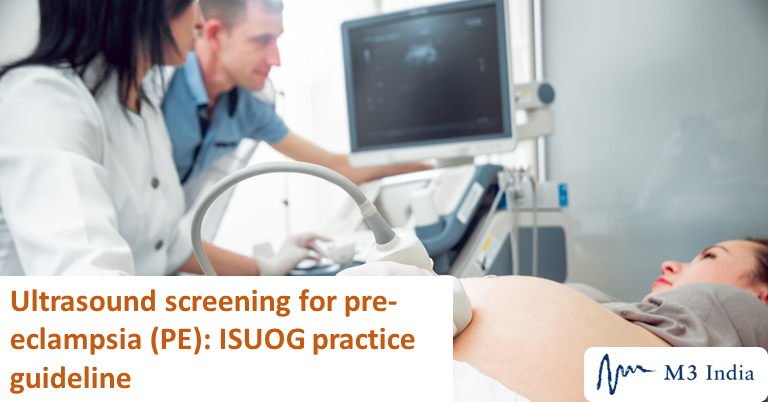Ultrasound screening for pre-eclampsia (PE): ISUOG practice guideline
M3 India Newsdesk May 31, 2019
Summary
The International Society of Ultrasound in Obstetrics and Gynecology (ISUOG) guidance document proposes evidence-based recommendations that deal specifically with the clinical and technical aspects of ultrasound screening, a non-invasive method to detect poor placental perfusion due to increased uterine PI, associated with pre-eclampsia (PE).

Pre-eclampsia (PE) and its complications are a major contributor to maternal and perinatal morbidity and mortality worldwide with an approximate global incidence of 3%. Given that timely and effective care can improve the outcome of PE, the development of effective prediction and prevention strategies has been a major objective of prenatal care and of research.
The International Society of Ultrasound in Obstetrics and Gynecology (ISUOG) has released evidence-based practice guidelines regarding the role of ultrasound in screening and follow-up of pre-eclampsia (PE). The guidance document has been published in the journal Ultrasound in Obstetrics and Gynecology.
The contributing authors of the guideline write, “For the purpose of this guideline, in the context of PE, ‘screening’ is the preferred term when identification of cases at risk may lead to prevention of its development, whereas ‘prediction’ is the preferred term when there is no evidence that identification of women at risk will eventually improve their outcome.”
Topics covered in the guidelines
- Screening for pre-eclampsia using ultrasound
- Which Doppler index to use
- First, second and third trimester
- Longitudinal changes in Doppler indices
- Placental volume
- Combined screening strategies
- Assessment of maternal hemodynamics
- Management after screening
- Multiple pregnancy
- Use of ultrasound in patients with established pre-eclampsia
Key recommendations
- Examiners involved in screening for pre-eclampsia (PE) should be up-to-date with the knowledge regarding its major risk factors
- Doppler index to use- The pulsatility index (PI) should be used for examination of uterine artery resistance in the context of PE screening
- First trimester: Doppler examination of the uterine arteries at 11 + 0 to 13 + 6 weeks can be performed either transabdominally or transvaginally, according to local preferences and resources
- The Doppler index of choice for screening in the 1st trimester is Mean uterine artery PI
- As maternal factors can affect uterine artery PI, its inclusion in a multifactorial screening model should, whenever feasible, be preferred over its use as a standalone test with absolute cut-offs
- Second, Third Trimester: Doppler examination of the uterine arteries at the second-trimester scan can be performed either transabdominally or transvaginally, according to local preferences and resources
- Mean uterine artery PI should be used for prediction of PE. In case of a unilateral placenta, a unilaterally increased PI does not appear to increase the risk for PE if the mean PI is within normal limits
- If offered in third trimester, mean uterine artery PI should be used for prediction of PE
Longitudinal changes in Doppler indices
Preventive strategies (e.g. low-dose aspirin) for reducing the risk of PE should be commenced as soon as possible in the first trimester for high-risk women, without waiting to assess the evolution of Doppler in the second trimester.
Placental Volume
Given the requirement of special equipment, time consumption and limited reproducibility, placental volume and vascularisation indices are not recommended for screening purposes.
Combined screening strategies
- A combination of maternal factors, maternal arterial blood pressure, uterine artery Doppler and PlGF (Placental growth factor) level at 11-13 weeks appears to be the most efficient screening model for identification of women at risk of PE
- Given the superiority of combined screening, the use of Doppler cut-offs as a standalone screening modality should be avoided if combined screening is available
- The transabdominal approach is preferred for calculating 1st-trimester individual patient risk
Assessment of maternal haemodynamics
Routine implementation in clinical practice as a stand-alone test is not recommended for the lack of enough data in its support.
Management after screening
Low-dose aspirin can decrease significantly the risk for development of early PE, when commenced at the time of 1st-trimester screening
Multiple pregnancies
- Due to increased placental mass in twin pregnancy, resulting in lower mean resistance in the uterine arteries, twin-specific reference ranges should be used for Doppler examination, if available
- The combined screening (maternal factors, uterine artery PI, mean blood pressure, PlGF) algorithm for singletons can also be used in twin pregnancy
- It can identify more than 95% of women with twin pregnancy who will develop PE
- However, the examiner should be aware that this is achieved at the cost of a 75% screen-positive rate
Use of ultrasound in patients with established pre-eclampsia
- Assess foetal status regularly in such patients as fetal deterioration is an indication for delivery in established PE
- The sonographic follow-up in pregnancies affected by PE includes assessment of fetal growth and biophysical profile, and fetal Doppler studies
- Consider examination of fetal biometry, amniotic fluid volume, uterine artery, UA and MCA PI and CPR, as well as placental visualisation to exclude abruption in women presenting with headache, abdominal pain, bleeding and/or reduced fetal movements
- Consider the same tests for women admitted for PE or with suspected PE, as well as for those with severe PE or HELLP syndrome
-
Exclusive Write-ups & Webinars by KOLs
-
Daily Quiz by specialty
-
Paid Market Research Surveys
-
Case discussions, News & Journals' summaries